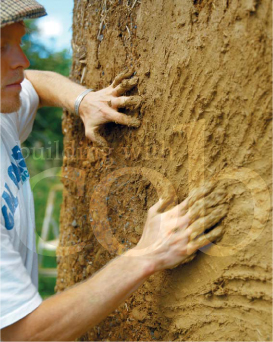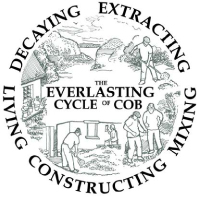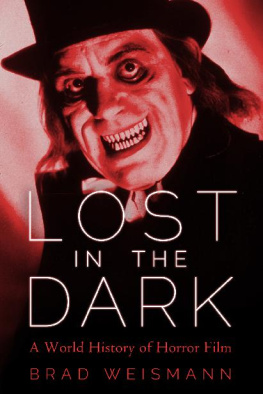Adam Weismann - Building with Cob
Here you can read online Adam Weismann - Building with Cob full text of the book (entire story) in english for free. Download pdf and epub, get meaning, cover and reviews about this ebook. publisher: UIT Cambridge Ltd., genre: Romance novel. Description of the work, (preface) as well as reviews are available. Best literature library LitArk.com created for fans of good reading and offers a wide selection of genres:
Romance novel
Science fiction
Adventure
Detective
Science
History
Home and family
Prose
Art
Politics
Computer
Non-fiction
Religion
Business
Children
Humor
Choose a favorite category and find really read worthwhile books. Enjoy immersion in the world of imagination, feel the emotions of the characters or learn something new for yourself, make an fascinating discovery.

- Book:Building with Cob
- Author:
- Publisher:UIT Cambridge Ltd.
- Genre:
- Rating:5 / 5
- Favourites:Add to favourites
- Your mark:
- 100
- 1
- 2
- 3
- 4
- 5
Building with Cob: summary, description and annotation
We offer to read an annotation, description, summary or preface (depends on what the author of the book "Building with Cob" wrote himself). If you haven't found the necessary information about the book — write in the comments, we will try to find it.
Building with Cob — read online for free the complete book (whole text) full work
Below is the text of the book, divided by pages. System saving the place of the last page read, allows you to conveniently read the book "Building with Cob" online for free, without having to search again every time where you left off. Put a bookmark, and you can go to the page where you finished reading at any time.
Font size:
Interval:
Bookmark:

Dedications
To our families Amy, Amir, Bev, Doug, Virginia, George, Anita, Chris, James, Jo and Albert for your enduring faith in us, your love, support and friendship. Without you all, none of this would be possible.
Christian Topf For your creativity, talent and patience.
Leslie and Jill Bishop For believing in us. Thank you so much for all your support.
Tim Reith For continually inspiring us through your friendship and enthusiasm.
Clare Marsh For helping us create our home in Cornwall.
Matt Robinson For introducing us to cob in England and for inspiring us to start our journey in Cornwall.
Linda Smiley and Ianto Evans Thank you for helping us to open our eyes and for starting us off on this journey.
PHOTO CREDITS All photos are by Katy Bryce, except the following:
Ray Main (.
Published in 2006 by Green Books Ltd, Foxhole, Dartington, Totnes, Devon TQ9 6EB edit@greenbooks.co.uk www.greenbooks.co.uk
Reprinted 2007, 2009
First published in digital formats 2010
Adam Weismann and Katy Bryce 2006-2010 www.cobincornwall.com
Section header illustrations: Carl Homstad Pen & ink illustrations: Christian Topf
Design & layout: Christian Topf Design (CTD) www.ctd-studio.co.uk
All rights reserved.
Print format ISBN 978 1 903998 72 4
PDF format ISBN 978 1 907448 26 3
ePub format ISBN 978 1 907448 27 0
DISCLAIMER: The authors and publishers accept no liability for personal injury, property damage or loss as a result of actions inspired by this book. Building work can be dangerous, and due care should always be taken.

Introduction

This book is not about going off to live in a cave It is not based on the idea that everyone can find an acre in the country, or upon a sentimental attachment to the past. It is rather about finding a new and necessary balance in our lives between what can be done by hand, and what still must be done by machine. Lloyd Kahn Shelter

W e live in interesting times. The last 150 years, since the industrial revolution began and the technological age took root, have brought rapid, dramatic changes to the world we inhabit. Some of these changes could be said to have brought about vast improvements in the general conditions of most peoples lives. On the other hand, some of these changes have brought about a false sense of progress, and two main outcomes have arisen. Firstly, the ecology of the planet is suffering badly. Although it is a naturally self-adjusting mechanism, and is designed to accommodate wastes and pollution, the changes that we have brought about have happened too quickly for it to adjust, and our levels of pollution and waste have become too much and too toxic for it to cope. We are at a crossroads. We can go one of two ways: either stumble blindly on into the future, and hope that something works itself out; or stop now, and start to make conscious changes on a personal level. We can become aware and conscious of the small and large decisions that we make on a daily basis. One of the most fundamental decisions we can make is what sort of a house we live in. What sort of materials is it made out of? Are they local, renewable, non-toxic, requiring little energy to produce? Does the overall design of the house require little energy to heat and cool? Can it make use of the free energy of the sun, and deal efficiently with wastes? Can it encourage communities to come together and build? Can it help to take some of the burden off our already stretched planet?

The second outcome that has arisen out of these dramatic and rapid changes has been our estrangement from the natural world. For without this estrangement, how could we have so easily and flippantly used and abused it so much? As we no longer directly relate to the natural world for our survival, for food, for shelter, there seems to have emerged a separation between wildlife and wilderness areas, and the civilised world shopping complexes and cityscapes. This is sad, not just because the natural world is suffering at the hands of our insensitivity (which will cause us suffering in the future, as it fights back), but because we too are suffering, through our estrangement to what is in fact a part of us, the whole of us. It should be a rich and rewarding symbiotic relationship: you give me some rocks and mud to build my house, and Ill do my best to honour and care for the land on which I am building.
To help us move forward, we can take a glimpse back to a period before the industrial revolution the last era in history when many people lived through this intimate, reciprocal relationship with the natural world. Or we can look at the tribes and communities throughout the world where industrialisation has not reached. We can study and learn from their buildings and dwellings, the ways they feed themselves, and their relationships with the land by which they are supported.

A unifying characteristic of these pre-industrial societies is their sense of holism, and their understanding that everything is linked, that all actions have an impact on all parts of the system, and that the whole is more important than the sum of its parts.
To these traditional societies, progress is not seen, as it is in our societies, as a linear concept, moving along a straight line from the past into the present and into the future. In industrial societies, at each stage newer and more sophisticated things are invented, so that we feel that we are better off today than we were yesterday. In traditional societies, time is seen as a circle, ever linked to the eternal cycles of nature the moon, the seasons, the spin of the earth around the sun, and the cycle of life and death.

Earth dwelling with hand-painted exterior decoration, India
On a metaphorical level, this book is about circles and cyclical time. On a practical level, this book is about building with cob (a simple mixture of clay subsoil, aggregate, straw and water). Through the process of building with cob we are encouraging you to reconnect to this wholesome, everlasting form. In the book we talk about coming full circle, back to those ideas and techniques of the past that really worked, such as walls built out of cob and roofs made out of thatch. We talk about the renewable cycles of natural building materials such as cob and stone which the planet is constantly making and which can be eternally re-used; or thatch and sustainably harvested wood, which will decompose safely when they have reached the end of their life, go back into the earth whence they came, and be turned into something new to nourish the garden.
We talk also about the use of lime as a building material, which has its own cycle as it moves from the ground as limestone, is processed into a material that can be plastered onto walls, at which point it reacts with the air, and effectively turns back into limestone. Lime can also be removed from a building, re-mixed, and re-used again.
Next pageFont size:
Interval:
Bookmark:
Similar books «Building with Cob»
Look at similar books to Building with Cob. We have selected literature similar in name and meaning in the hope of providing readers with more options to find new, interesting, not yet read works.
Discussion, reviews of the book Building with Cob and just readers' own opinions. Leave your comments, write what you think about the work, its meaning or the main characters. Specify what exactly you liked and what you didn't like, and why you think so.










